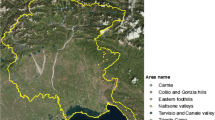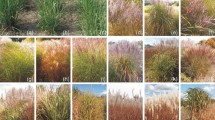Abstract
Key message
This study is the first to report a core set of polymorphic SSR markers in Torreya grandis developed to identify T. grandis cultivars and breeding strains and estimate ploidy levels.
Abstract
Torreya grandis Fort. ex Lindl has a high economic value because it produces edible, nutrient seeds with high oil content as food for thousands of years in China. T. grandis has rich variation in morphological traits and ploidy levels as well as commonly occurring natural hybridization. In this regard, an efficient molecular method should be developed to identify T. grandis cultivars and strains and determine ploidy levels for breeding program. In this study, 25 T. grandis materials with different ploidy levels including 17 cultivars and 8 strains were collected and analyzed with a core set of 10 polymorphic simple sequence repeat (SSR) markers developed from the transcriptome data. The ploidy level of the materials was estimated through SSR marker genotyping and flow cytometry (FCM). The polymorphism information content (PIC) values for 10 SSR loci indicated that six loci were highly polymorphic, three loci were average polymorphic, and one loci was low polymorphic. The SSR genotyping profiles and the UPGMA clustering demonstrated that the 10 core SSR markers can be used as effective DNA fingerprints to identify most of the 25 T. grandis materials including all polyploids. The ploidy level estimated from SSR marker genotyping corresponded with that estimated by FCM among 17 diploid and 5 triploid materials but not among 1 tetraploid. Tg_U33 was a highly heterozygous locus that can be used to rapidly and efficiently identify ploidy levels in T. grandis materials from a large number of samples.




Similar content being viewed by others
Data availability
All authors declare that the data presented in paper belong to authors.
Code availability
Not applicable.
References
Botstein D, White RL, Skolnick M, Davis RW (1980) Construction of a genetic linkage map in man using restriction fragment polymorphisms. Am J Hum Genet 32:314–331
Bungartz A, Klaus M, Mathew B, Léon J, Naz AA (2016) Development of new SNP derived cleaved amplified polymorphic sequence marker set and its successful utilization in the genetic analysis of seed color variation in barley. Genomics 107:100–107
Chen K (1990) C-banding analysis for the complement of triploid Torreya grandis. Acta Botanica Sinica 32(3):731–732 (in Chinese)
Chen H, Chen H, Zhang L, Jiang R, Xu X, Chen X (2004) An investigation on the germplasm resources of Chinese Torreya in Panʼan county of Zhejiang province. For Res 17(5):660–665 (in Chinese)
Chen H, Zhang S, Zhang G, Hu D, Yao X, Yu W (2018) Comparison on seed traits of different natural types of Torreya grandis in Panʼan. J Zhejiang for Sci Technol 38(6):19–28 (in Chinese)
Chen H, Li G, Zhang S, Ma W, Yao X, Zhang C, Zhang M (2020a) Breeding report of a new Torreya grandis cultivar ‘Pan’an Changfei.’ J Fruit Sci 37(2):297–300 (in Chinese)
Chen H, Tang H, Zhang S, Zhang C, Yu W, Zhang M (2020b) Breeding report of a new Torreya grandis cultivar‘Yushanyufei.’ J Fruit Sci 37(5):779–782 (in Chinese)
Chen H, Cao Z, Huang Y, Cao W, Yang J, Chen S (2021) Comparison on extra large seed traits of cultivars and strains of Torreya grandis. J Zhejiang for Sci Technol 41(4):1–9 (in Chinese)
Cheng XJ, Li ZJ, Dai WS, Yu WW, Zeng YR (2009) Investigation and evaluation of Torreya grandis germplasm resource. J Fruit Sci 26(5):654–658 (in Chinese)
Dai Z, Chen L, Tong P (2008) Genetic variation and fingerprinting of Torreya grandis cultivars detected by ISSR markers. Acta Horticulturae Sinica 35(8):1125–1130 (in Chinese)
Garcia-Vallve S, Palau J, Romeu A (1999) Horizontal gene transfer in glycosyl hydrolases inferred from codon usage in Escherichia coli and Bacillus subtilis. Mol Biol Evol 16(9):1125–1134
Hu CY, Tsai YZ, Lin SF (2014) Development of STS and CAPS markers for variety identification and genetic diversity analysis of tea germplasm in Taiwan. Bot Stud 55:12
Huang S, Wang Y, Zhao Z, Ren Q, Guo Q, Gu B (1990) Early identification of Chinese Torreya sexuality. For Res 3(2):127–132 (in Chinese)
Jia H, Ji H, Hu J, Lu M (2015) Fingerprints of SSR markers and ploidy detection for new Populus varieties. Scientia Silvae Sinicae 51(2):69–79 (in Chinese)
Kang N, Tang ZX (1995) Studies on the taxonomy of genus Torreya. Bull Bot Res 15:349–362
Kumar S, Banks TW, Cloutier S (2012) SNP discovery through next-generation sequencing and its applications. Int J Plant Genom 2012:831460
Kurokochi H, Uchiyama H, Hasegawa M, Saito Y, Ide Y (2014) First report of triploidy in Ailanthus altissima, an invasive tree species. J Res 19(5):469–472
Liu Y, Li M, Zhu J, Yang L, Gao J, Kong D, Li Y, Pang X (2018) Excavation and SSR identification of polyploid germplasm resources in Jujube trees. Mol Plant Breeding 16(10):3395–3400 (in Chinese)
Liu HK, Hui Z, Chen WC, Yu WW, Dai WS, Zeng YR (2021) Genetic diversity of the male and species in Torreya grandis based on SRAP analysis. Mol Plant Breeding 19(12):4153–4158 (in Chinese)
Ong P, Maizura I, Abdullah N, Rafii M, Ooi L, Low E, Singh R (2015) Development of SNP markers and their application for genetic diversity analysis in the oil palm (Elaeis guineensis). Genet Mol Res 14:12205–12216
Rohlf FJ (1992) NTSYS-pc: numerical taxonomy and multi-variate analysis system, version 1.7. Exeter Software: Setauket, NY
Rozen S, Skaletsky HJ (2000) Primer 3 on the WWW for general users and for biologist programmers. In: Krawetz S, Misener S (eds) Bioinformatics methods and protocols: Methods in molecular biology. Humana Press, Totowa, pp 365–386
Serrote CML, Reiniger LRS, Silva KB, dos Santos Rabaiolli SM, Stefanel CM (2020) Determining the polymorphism information content of a molecular marker. Gene 726:144175
Tan X, Hu F, Zhang D, Zhou X, Yang W (2002) Molecular identification of main cultivars of Torreya grandis by RAPD markers. Acta Horticulturae Sinica 29(1):69–71 (in Chinese)
Tóth G, Gáspári Z, Jurka J (2000) Microsatellites in different eukaryotic genomes: survey and analysis. Genome Res 10:967–981
UPOV (Union for the Protection of New Varieties of Plants) (2005) Guidelines for molecular marker selection and database construction, BMT Guidelines (Proj 3), UPOV, Geneva, pp 3–6
UPOV (2002) General introduction to the examination of distinctness, uniformity and stability and the development of harmonized descriptions of new varieties of plants. UPOV, Geneva, Switzerland
Viruel J, Conejero M, Hidalgo O, Pokorny L, Powell RF, Forest F, Kantar MB, Soto Gomez M, Graham SW, Gravendeel B, Wilkin P, Leitch IJ (2019) A Target capture-based method to estimate ploidy from herbarium specimens. Front Plant Sci 10:937
Wang Y, Du HM, Zhang J, Chen T, Chen Q, Tang HR, Wang XR (2018) Ploidy level of chinese cherry (Cerasus pseudocerasus lindl.) and comparative study on karyotypes with four Cerasus species. Sci Hortic 232(17):46–51
Whittemore AT, Olsen RT (2011) Ulmus americana (Ulmaceae) is a polyploid complex. Am J Bot 98(4):754–760
Wu Q, Liang X, Dai X, Chen Y, Yin T (2018) Molecular discrimination and ploidy level determination for elite willow cultivars. Tree Genet Genomes 14:65
Xu X, Shao W, Zheng W (2018) Ploidy study on polyploidy cultivars of Camellia reticulata. Scientia Silvae Sinicae 54(9):44–48 (in Chinese)
Yagi M, Kimura T, Yamamoto T, Onozaki T (2009) Estimation of ploidy levels and breeding backgrounds in pot carnation cultivars using flow cytometry and SSR markers. J Japan Soc Hort Sci 78(3):335–343
Yi G, Qiu ZT, Yin Z, Tang P, Qiu Y, Yao X (2016) Mining and characterizing EST-SSR markers from ESTs of Torreya grandis. Biochem Syst Ecol 65:124–128
Zeng YR, Ye SY, Yu WW, Wu S, Hou W, Wu RL, Dai WS, Chang J (2014) Genetic linkage map construction and QTL identification of juvenile growth traits in Torreya grandis. BMC Genet 15(Suppl 1):S2
Zeng J, Chen J, Kou Y, Wang Y (2018) Application of EST-SSR markers developed from the transcriptome of Torreya grandis (Taxaceae), a threatened nut-yielding conifer tree. PeerJ 6:e5606
Zhang M, Zhou C, Chen T, Dai W, Zhang C (2017) Analysis of SSR information in transcriptome and development of molecular markers in Torreya grandis. J Fruit Sci 34(10):1258–1265 (in Chinese)
Zhou XR, Zhang W, He XJ, Zhou SD, Yu Y (2012) Resources and conservation of Torreya fargesii. J Northeast for Univ 40(2):42–46 (in Chinese)
Acknowledgements
The authors gratefully acknowledge the funding provided by the Forestry Science and Technology Project of Zhejiang Province (Grant no. 2019SY09). We are also very grateful to senior engineer Hongxing Chen for providing us with some plant materials used in this study.
Funding
A funding declaration is mandatory for publication in this journal. Please confirm that this declaration is accurate, or provide an alternative.
Author information
Authors and Affiliations
Corresponding author
Ethics declarations
Conflicts of interest
The authors declare that they have no conflict of interest.
Additional information
Communicated by Gómez .
Publisher's Note
Springer Nature remains neutral with regard to jurisdictional claims in published maps and institutional affiliations.
Supplementary Information
Below is the link to the electronic supplementary material.
Rights and permissions
About this article
Cite this article
Chen, Y., Ye, B., Song, Q. et al. Estimation of ploidy levels by flow cytometry and identification of Torreya grandis cultivars and breeding strains by SSR markers. Trees 36, 1735–1745 (2022). https://doi.org/10.1007/s00468-022-02324-x
Received:
Accepted:
Published:
Issue Date:
DOI: https://doi.org/10.1007/s00468-022-02324-x




